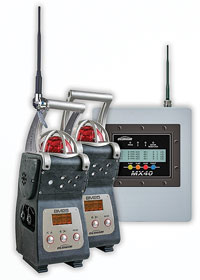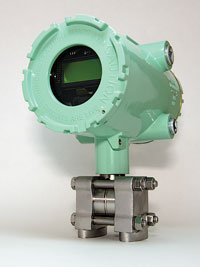What’s new in gas processing technology
H. Meche, Associate Editor
Rotork secures pipeline actuator order
 |
Rotork GO gas-over-oil actuators have been supplied for failsafe valve control duties on a new cryogenic LNG pipeline in Venezuela. The actuators were selected partly because of the high level of local support available from Rotork’s well-established company in Venezuela.
The San Joaquin pipeline, owned by Venezuelan state oil company PDVSA, transports LNG for the international market between the San Joaquin and Jose cryogenic plants. The Rotork actuators operate 26-in., 20-in. and 12-in. ball valves installed in tandem with non-return check valves at six valve stations along the route.
The Rotork GO actuator design uses pipeline gas as the motive power source, converting the gas into hydraulic pressure to ensure valve control. Isolating the actuator cylinder from the pipeline gas eliminates potential contamination, corrosion and seal deterioration, extending the actuator’s life. A dedicated pump is used in each operating direction to prevent leakage and/or contamination between the gas-over-oil tanks.
The gas-over-oil system’s manifold block integrates gas control functions to facilitate a range of failsafe and emergency shutdown options for pipeline events including line break, low-pressure close and high differential inhibition.
The manifold has the facility for a high-flow hand pump, pressure relief and a locking handle.
Rotork GO actuators are IP66M/67M third-party certified and approved for environmental protection, together with CE and ATEX hazardous-area certification. The standard working operating pressure range is 10 barg to 105 barg, enabling a quarter-turn operating torque of up to 600,000 Nm and linear thrust of 5,000,000 N.
Monitor locates methane in shale area
Scientists from the US Geological Survey, Pennsylvania State University and the University of Utah have used a new, stream-based methane monitoring method to identify and quantify groundwater methane discharging to a stream in an area of shale gas development.
Recently published in Environmental Science and Technology, the report describes how the technique was applied in northern Pennsylvania to first identify streams with elevated methane. Detailed sampling of one such stream, Sugar Run, identified an inflow of approximately 0.5 kg/d of methane to the stream.
While the presence of methane has been documented in some Pennsylvania homeowner wells, the extent of stray gas contamination in shallow aquifers above the Marcellus is controversial because some wells contained measurable levels of methane prior to Marcellus development.
Understanding of the extent of contamination is limited because of the lack of groundwater-monitoring networks and publically available predevelopment baseline data. Furthermore, no assessments have been made of the rate of either natural or human-induced causes of methane migration into aquifers.
Such information is needed to understand how hydrocarbons enter freshwater resources and how often such migration is caused by shale gas development. Since no baseline stream hydrocarbon samples had been collected prior to this stray gas migration incident, the scientists were unable to definitively conclude that the methane in the stream was associated with stray gas migration. However, documentation of this gas well methane release and the methane contamination of nearby domestic supply wells, along with the lack of correlation with increased salinity in the stream, all suggest that the source of methane to the stream may be stray gas rather than natural migration of crustal fluids.
The USGS has been developing and testing the stream methane monitoring method at several locations as a tool for evaluating the impacts of unconventional gas development on groundwater.
DNV updates RPs for pipeline sector
Together with its industry partners, DNV GL has updated two recommended practices (RPs): corroded pipelines and integrity management of submarine pipeline systems. The revisions will further support decision-making processes.
The latest update to DNV-RP F101 includes a new assessment methodology on how to estimate the pressure resistance of a pipeline containing long axial grooving and other patterns of internal corrosion.
Updates have been made to achieve better compliance with the newest edition of the offshore standard DNV-OS-F101 rev. 2013-10—e.g., with regard to pressure definitions and terminology; characteristic material properties; partial safety factors and fractile values; and supplementary material requirements.
Revisions to DNV-RP F101 aim to improve corrosion defect assessments through probabilistic evaluation, corrosion development evaluations and pressure-resistance calculations accounting for system effects.
Revisions to DNV-RP-F116 provide comprehensive guidelines for carrying out risk assessments. Guidelines for integrity management reviews, as well as recommendations for identifying key performance indicators, have been revised and updated.
Wireless gas detection solutions
 |
After introducing its wireless BM 25 worksite system, Oldham Gas is expanding its product range with the new MX 40 gas detection controller. Designed to centralize information transmitted by the BM 25 system over a wireless network, the controller can display up to 32 measurements in real time.
When a BM 25 system signals an alarm, the MX 40 controller also goes into alarm mode and can, for example, control internal relays and order other monitors to also transmit the alarm.
The controller can connect to up to 16 BM 25 units on the same wireless network, and up to 16 different networks can be used independently. The wireless technology used allows for fast deployment, easy upgrades for coverage and high fault tolerance, thereby reducing network installation and operation costs.
Gas engines boost electrical efficiency
GE has achieved 50.1% electrical efficiency on its 10-MW gas engine platform in a test environment in Austria. The company is investing $1.4 B in distributed power technology and is expanding its reciprocating engine offerings to meet onsite power, heating and environmental needs of the oil and gas sector and other industries.
GE’s 10-MW Jenbacher J920 FleXtra gas engine is designed to achieve high electrical efficiency. Its design is said to enable high-power density for a lower investment cost. Two-stage turbocharging technology allows stable power output and efficiency at high ambient conditions. Additionally, the modular design allows for fast installation
in both industrialized zones and remote areas.
Distributed power is becoming increasingly popular in countries seeking more reliable, efficient energy options near the point of use. It is projected to grow 40% faster than global electricity demand between 2014 and 2020.
Turbine flowmeter gets update
 |
Turbines Inc. has updated its cryogenic turbine flowmeter for industrial, chemical, and research and development applications. The TMC series cryogenic turbine flowmeter has an all-stainless-steel body and shaft, with a nickel rotor in all available line sizes.
With a temperature range of −450°F to +450°F, the cryogenic meters are designed for extreme temperature applications, and they offer an increased performance flowrate range to 12,000 gpm.
Transmitter with integrated data-logging
 |
Newgate Instruments’ JT400 ultra-low-power wireless multivariable transmitter features integrated chart replacement data-logging. For measurement of differential pressure, static pressure and process temperature, the JT400 transmitter provides accuracy in an explosion-proof package. It offers historical data-logging, wireless communication, analog and digital input and output, USB connectivity and a selection of integral power sources.
The transmitter replaces manual gas well chart recorders with a hands-free transmitter capable of operating autonomously in harsh environments. The unit uses less power than traditional multivariable transmitters and features an increased battery life. A solar-powered option can operate for up to six months without sunlight.
For custody-transfer measurement applications, the transmitter provides an API 21.1-compliant historical data log that maintains 15-min averages for more than 35 days. The transmitter is also said to be the industry’s first multivariable transmitter to offer a local USB interface for configuration and data downloading.
The transmitter is compatible with nearly all upstream, midstream and pipeline installations.
Gas tool models multiphase flow
DNV GL’s new Multiphase Module in Synergi Gas software enables gas gathering and transmission companies to take control of their multiphase network analyses. Multiphase flow is common in gas gathering systems, where temperature and pressure changes cause liquid components of the gas to drop out, resulting in a mixed flow of natural gas, hydrocarbon liquid and water. The Multiphase Module calculates phase change and pressure loss along pipelines, and it provides an improved understanding of liquid accumulation in the lines.




Comments